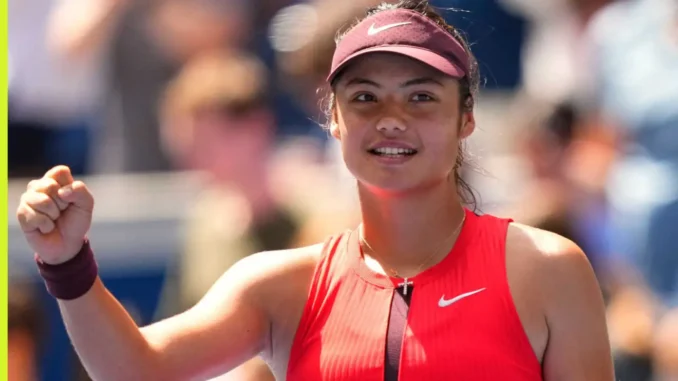
In the dazzling crucible of professional tennis, where every forehand carries the weight of dreams and every match tests the limits of resolve, Emma Raducanu’s 2025 season has been a testament to grit and growth. The 22-year-old British star, whose 2021 US Open victory as a teenage qualifier remains a beacon of sporting folklore, has clawed her way back from injury-plagued lows to reassert her place among the WTA’s elite. Her recent third-round exit at the China Open in Beijing, a heart-wrenching 6-3, 6-7(9-11), 0-6 loss to Jessica Pegula, wasn’t the crescendo she craved but a springboard for a thrilling season finale. With two pivotal tournaments on the horizon—Wuhan and Tokyo—Raducanu’s meticulously crafted plan is not just about closing out 2025; it’s about vaulting into 2026 with a top-25 ranking, a coveted Australian Open seed, and the consistency that could redefine her career. “It was a tough one—Jess was on fire, and I fought every point, but sometimes you just have to tip your hat,” she reflected post-match, her voice steady with the resolve that’s come to define her.
Beijing, though a defeat, was no dead end. Raducanu’s Asian Swing showcased her resurgence: a dogged first-round win over Cristina Bucsa and a second-round epic against Jaqueline Cristian, sealed with a tearful embrace, pushed her live ranking to No. 32—a milestone she’d quietly targeted months earlier. “This means everything,” she whispered after that victory, a nod to her climb from the sub-300 depths of 2023, when ankle and wrist surgeries sidelined her for months. Her 2025 ledger sparkles: a 27-19 record, upsets over Naomi Osaka and Victoria Azarenka, and $1.36 million in prize money. Under coach Francisco Roig’s guidance since August and with fitness guru Yutaka Nakamura—veteran of Maria Sharapova and Osaka’s camps—Raducanu’s game now boasts a 68% first-serve win rate and a forehand that bites. Yet, the Pegula loss, where a valiant tiebreak couldn’t stem a third-set collapse, underscored the razor-thin margins at the top. It’s a lesson she’s carrying into her final act, where every point counts toward her ultimate goal: seeding at Melbourne to avoid early-round clashes with Grand Slam titans like Iga Swiatek or Elena Rybakina, who’ve repeatedly halted her major runs.
First on the docket is the Wuhan Open, October 6-12, a WTA 500 event in Hubei’s electric arena. Known as the “Fifth Slam” for its prestige and 500-point haul, Wuhan’s indoor hard courts are tailor-made for Raducanu’s aggressive returns and deft net play. Past champions like Aryna Sabalenka have used its slick surface to ignite late-season surges, and Raducanu sees it as her chance to paint a masterpiece. “Wuhan’s got that electric vibe—big crowds, big points. I’m heading there to build on Beijing and really push the envelope,” she told her team, her ambition undimmed by China’s sting. With no points to defend from 2024, every win here is a rankings rocket, though she’ll face a gauntlet of stars like Ekaterina Alexandrova’s power game or Clara Tauson’s rising threat. A quarterfinal run could net 185 points, inching her closer to the 1,245 needed to crack the top 25 and secure that Melbourne seed.
Next, Raducanu heads to Tokyo’s Pan Pacific Open, October 20-26, at the storied Ariake Coliseum, where legends like Martina Hingis and Naomi Osaka have etched their names. As a projected No. 30 seed, she’ll face a stacked field—defending champion Qinwen Zheng, Rybakina, and wildcard Osaka herself—on indoor hard courts that reward her silky slices and thunderous forehands. “Tokyo’s always special—it’s got that blend of pressure and passion. After Wuhan, it’ll be about peaking at the right time, grabbing those seeds for the majors,” she said, her focus laser-sharp. The event’s $900,000 purse and 500 points make it a high-stakes crucible, where a semifinal push could add 350 points and vault her past her 2024 total of 1,104. Her decision to skip November’s Billie Jean King Cup, prioritizing recovery after a grueling year, reflects a body-first strategy that’s kept her injury-free—a far cry from the surgeries that once derailed her.
This finale is more than a schedule; it’s a narrative of redemption. Raducanu’s 2025 began with a third-round Australian Open run—her best yet—before top-10 titans like Swiatek, Sabalenka, and Rybakina halted her at majors. Her US Open, where she toppled Alexandrova before falling to Rybakina, showed flashes of 2021 brilliance. Now, with 1,245 points already banked, Wuhan and Tokyo offer a shot at 1,000 more, potentially thrusting her into WTA Finals chatter for 2026. Off the court, her resilience shines: navigating a Dubai stalking scare that spurred WTA safety reforms and a Vodafone split, she’s channeled Romanian-Chinese-British grit into her craft. Tim Henman, Britain’s tennis sage, sees the path clear: “Top 30 is hers; top 20 is next if she stays healthy and strings wins together.”
As October’s Asian lights beckon, Raducanu’s China Open exit isn’t a curtain call but a prelude. “Every setback’s just setup for the comeback,” she told her inner circle, a mantra born of her qualifier-to-queen journey. In Wuhan’s roar and Tokyo’s intensity, she’s not just chasing points—she’s scripting a legacy. Picture her trading blows with Paolini or outwitting Kenin, her baseline dance a reminder that tennis’s greatest stories are forged in perseverance. With 2026’s Grand Slams on the horizon, Raducanu’s finale is her chance to turn promise into power, one electrifying rally at a time.
Leave a Reply